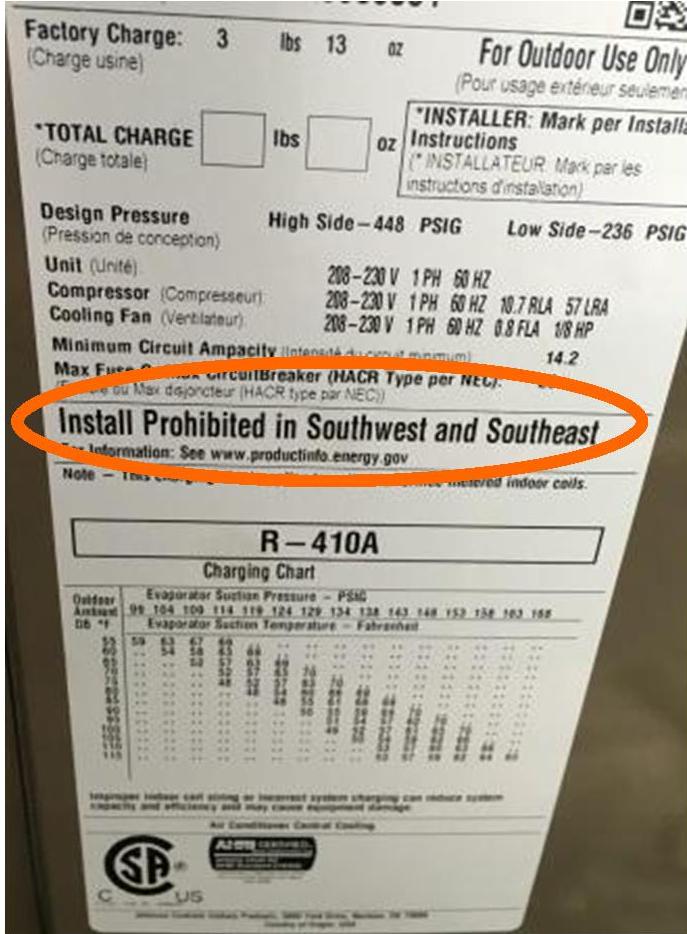Heat Pump / Central Electric Air Conditioner Federal Requirements

Recently I was conducting an inspection on a central electric air conditioning unit. While examining the outside condenser unit, I saw the following: “Install Prohibited in Southwest and Southeast”. Fortunately for my client (and me) we were in the northeast! You can see in the photo above the circled text on the manufacture tag. New Federal Energy standards were enacted January 1, 2015 and the law pertaining to them was updated December 22, 2016. The U.S. Department of Energy (DOE) has divided the nation into 3 regions; North, Southeast, and Southwest. If you live in the North, all units manufactured after January 1, 2015 must meet the new standards. For the Southeast or Southwest, the standards are based on the date of installation. Therefore any unit installed in the South after January 1, 2015 would meet the standard. The DOE would not penalize installers who install units manufactured prior to January 1, 2015, so the installer may, until July 1, 2016, offer to sell you a non-compliant unit that was manufactured earlier. After July 1, 2016, however a contractor should not install in the south any unit that does not meet the new standard. According to Federal Energy Law, Title 10 Energy, Article 429, manufactures and installers must keep records regarding the units they are producing, selling and installing. Violators can be fined and installers could be prohibited from purchasing units from a manufacturer. The standards are for split-systems and for standard central electric heat pump units. So what does a home inspector need to know and properly advise their clients:
First some definitions…
- Seasonal Energy Efficiency Ratio (SEER) is the total heat removed from the conditioned space during the annual cooling season divided by the total electrical energy consumed by the air conditioner. The higher the SEER rating, the less electrical energy used. Higher rated SEER units normally cost more; however will save money in the long term.
- Energy Efficiency Ratio (EER) is the ratio of the cooling capacity in BTU’s per hour to power input in watts at 95° F. EER is especially important in hot-dry climates, where units work harder to cool the home. The higher the EER rating the more efficient the unit is.
Federal DOE Standards as of January 1, 2015
Split-system Requirements
- Split-system in the north must have a minimum SEER rating of 13.
- Split -systems installed in the Southeast and Southwest must have a minimum SEER rating of 14.
- Split-systems in the southwest with a capacity of less than 45,000 Btu/h must have an EER rating of at least 12.2. Units with a capacity of greater than 45,000 must have a rating of at least 11.7
Standard Central Air Conditioners and Heat Pumps – All Regions
- All split-system heat pumps & Air Conditioners must have a SEER rating of at least 14
- All small duct, high velocity systems, space constrained air conditioners and heat pumps must have a minimum SEER rating of at least 12
Related Articles
- Window Leaks
- Inspecting Hot Water Circulation Systems
- Inspecting Direct Vent Water Heaters
- Inspecting Heat Pump Water Heaters
Want To Learn More? Click HERE to Search Our Full Database Of Home Inspector Newsletters.



